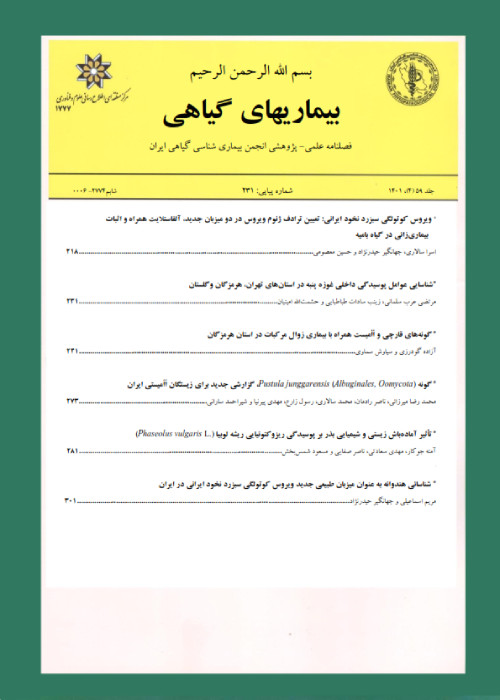IDENTIFICATION OF THE CAUSAL AGENT OF A LEAF SPOT OF PRIMULA BY DNAK AND RPOD GENE SEQUENCES IN MAZANDARAN
Author(s):
Abstract:
A leaf spot disease caused by strains of Xanthomonas in wild primrose (Primula vulgaris) were reported in several forest locations of Mazandaran (Rahimian. 1995. 12th Iran. Plant Protec. Cong. P. 278). Based on a genomic study of ITS area and 16S rRNA gene sequencing, it was reported that some isolates causing leaf spot of P. vulgaris probably belong to X. campestris (Rahimian et al. 2008. 18th Iran. Plant Protec. Cong. P. 420). but there is insufficient information available on the taxonomical status of these isolates. The present study wase performed to evaluate the taxonomic position of the isolates obtained from several forest areas of Mazandaran province. Yellow-pigmented٫ round and convex Xanthomonas-like colonies were isolated from the diseased plants. Hypersensitive reaction (HR) after 24 hours injection of bacterial suspension to geranium leaves and pathogenicity on P. vulgaris leaves after 7 to 14 days were proven. Only slight differences were observed among the electrophoretic pattern of cell proteins of the strains. Strains were very similar phenotypically and differed mainly in utilization citrate as carbon soure for growth. Genomic DNA of isolates was extracted and PCR was done under previously described conditions (Parkinson et al. 2007. Int. J. Syst. Evol. MicrobioI. 57:2881-2887) reducing the annealing temperature. Products were electrophoresed in %1 gel and the gel was stained with gel red solution. Using dnak and rpoD primers fragments 965 and 736 bp in size٫ were amplified in PCR٫ respectively. For differentiation of the isolates٫ the PCR products were digested with BamHI and electrophoresed on acrylamid gel. Dendrograms were constructed using the data sets obtained after digestion of dnak and rpoD amplified fragments with the restriction enzyme, using the Jaccard coefficient, the UPGMA algorithm and the NTSYS-PC program. Selected samples were sequenced based on RFLP results. The nucleotide sequence obtained٫ after multiple sequence alignment٫ were compared٫ with MEGA version 4. 0٫ with other sequences to various Xanthomonas species present in the Gene Bank (NCBI). Results٫ showed that isolates resembled٫ at 98% similarity٫ with strains of Xanthomonas hortorum deposited in GeneBank٫ but probably belong to a pathovar distinct from the existing ones in this spesies. This is the first report of Xanthomonas hortorum causing a leaf spot disease on Primula.
Language:
Persian
Published:
Iranian Journal of Plant Pathology, Volume:48 Issue: 2, 2012
Page:
287
magiran.com/p1053492
دانلود و مطالعه متن این مقاله با یکی از روشهای زیر امکان پذیر است:
اشتراک شخصی
با عضویت و پرداخت آنلاین حق اشتراک یکساله به مبلغ 1,390,000ريال میتوانید 70 عنوان مطلب دانلود کنید!
اشتراک سازمانی
به کتابخانه دانشگاه یا محل کار خود پیشنهاد کنید تا اشتراک سازمانی این پایگاه را برای دسترسی نامحدود همه کاربران به متن مطالب تهیه نمایند!
توجه!
- حق عضویت دریافتی صرف حمایت از نشریات عضو و نگهداری، تکمیل و توسعه مگیران میشود.
- پرداخت حق اشتراک و دانلود مقالات اجازه بازنشر آن در سایر رسانههای چاپی و دیجیتال را به کاربر نمیدهد.
In order to view content subscription is required
Personal subscription
Subscribe magiran.com for 70 € euros via PayPal and download 70 articles during a year.
Organization subscription
Please contact us to subscribe your university or library for unlimited access!


